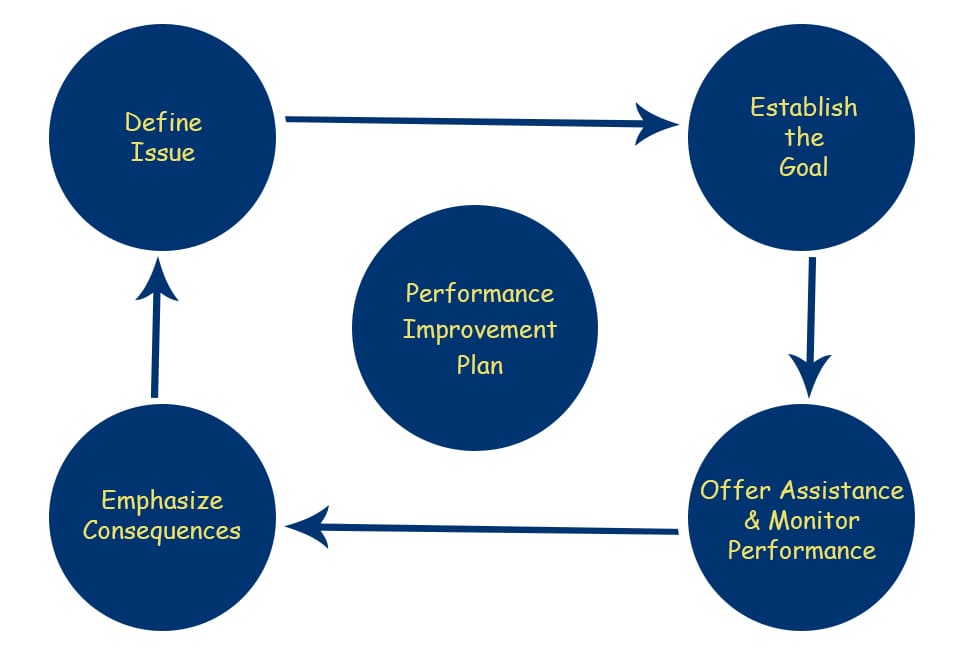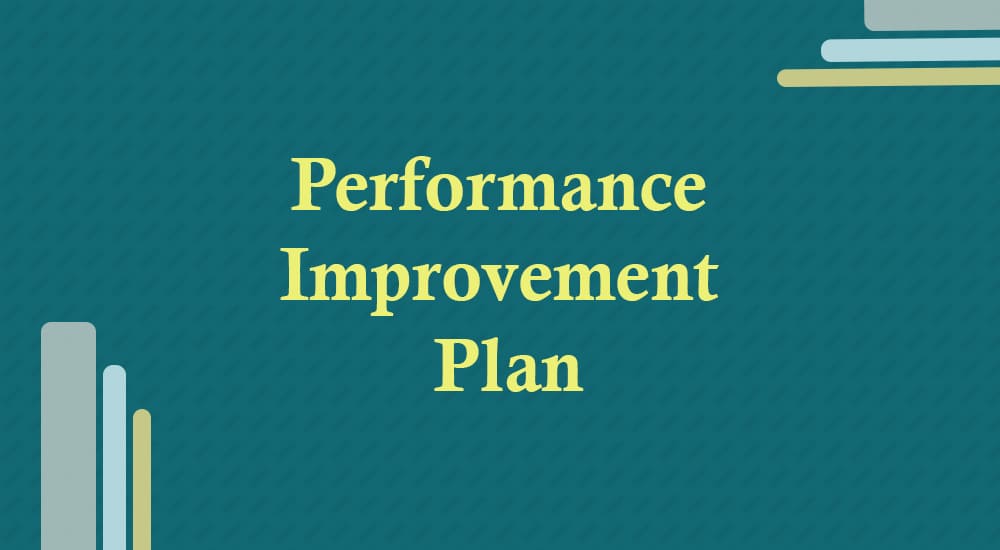A performance improvement plan (PIP) provides a measurable path to achievement for struggling employees or those seeking a promotion.
This post will go through the benefits of a performance improvement plan and how to respond if an individual is placed on one. It also distinguishes between a performance improvement plan and a personal improvement plan.
What Is a Performance Improvement Plan (PIP)?
Definition: A performance improvement plan is a formal strategy for an employee who is struggling at work is a performance improvement plan. It assists an employee in overcoming performance challenges and navigating difficult situations.
A performance improvement plan should meet the following criteria:
- It should be created and approved by the employee’s manager and human resources department.
- It should have specific actions for an employee to improve their performance.
- It should have specific objectives and a deadline.
- If an employee does not meet the PIP requirements (demotion, dismissal, or transfer to another department), it explains the result.
The Benefits of a Performance Improvement Plan
A performance improvement plan addresses an employee’s inability to accomplish job goals or resolve behavior-related issues.
The benefits of PIP are
- It makes employees aware of the performance issues that need to be solved.
- Employees can see the organization‘s commitment to their development.
- It helps keep excellent employees who may be struggling with particular issues at work.
- It makes employees more efficient as they know their targets and the consequence of not achieving them.
Performance Improvement Plan Examples
Here are examples of PIPs:
Example 1: Data Entry Clerk – Erroneous Data Entry.
Mary Ann, Data Entry Clerk.
18/05/2022
Problems with Performance
Last month, on April 10th, we discussed data entry issues.
Marry entered incorrect data on two occasions, and the problem was not discovered until the data was analyzed. On May 18th, another issue in recording customer engagement data was discovered. One variable was left in the data collection by Marry. It caused misleading visualization.
Expectations
Be cautious while entering data and double-check all inputs. Ensure that data is processed correctly and that visualizations are accurate.
Actions
- Double-check inputs after completing each data entry activity for at least 1 hour.
- Have someone else check the work for correctness.
- Complete training on SPSS best practices and data processing by June.
- A supervisor will monitor the progress every week.
The performance improvement plan is implemented for two months.
On July 18th, the results will be evaluated.
Example 2: Content Writer – Time Management And Missed Deadlines
John Doe
01/05/2022
Performance Problem
John’s time management and capacity to finish things on time have been established as part of his performance improvement plan.
Last month, John promised ten pieces of content but only provided five. He attributed the delay to a lack of time and the lack of essential resources. He missed deadlines for sending content to editors on two occasions. The process of adding new content to websites was hindered as a result.
Actions & Expectations
The following is the performance improvement plan for John for the next 60 days.
- Work with management to set a reasonable monthly content volume.
- Keep the editors and manager updated on the daily progress.
- Reduce new copy development time to 3 hours per 1,000 words.
- Meet all deadlines on time and aim to submit at least one hour ahead of time.
- A one-on-one meeting with management to review efforts until the performance improvement plan is completed in three months.
How To Create a Performance Improvement Plan

Step 1: Define the Issue
Managers must identify the employee’s errors and performance concerns. Negative points should be well-defined, with examples of poor work or behavior. Managers should avoid their thoughts or feelings.
Managers can decide whether an employee needs a PIP. Without employing a PIP, managers can resolve difficulties by talking to employees about their bad performance and methods to improve.
This type of discussion will inspire employees to participate in their development. Poor performance by the employee will be more obvious. Employee concerns might range from overworked to unmet expectations, with personal troubles at home as a result.
Allow the employee to be heard.
Step 2: Establish the Goals
After defining the performance issues, it’s time to set the SMART objective for PIP. Therefore, they have measurable outcomes and specific numbers and dates.
- S stands for Specific. Specific goals are effective and beneficial.
- M stands for measurable. They are estimable and trackable.
- A stands for attainable. The goals should be challenging but attainable.
- R stands for relevant. They should be beneficial to an employee.
- T stands for time-bound. They have check-in sessions and deadlines.
Step 3: Offer Assistance and Monitor Performance
At this point, management must identify the steps that employees must take to attain their objectives. They can offer help, training, and other information sources, among other things.
Assure the employee of the full support of the management. Create a routine with regular performance checks after that.
Before the deadlines, managers should schedule regular meetings with their personnel. Intermittent feedback improves the effectiveness of error-correcting efforts. A manager can help an employee self-correct before the deadline by correcting and guiding their development in accordance with the PIP objectives.
Step: 4 Emphasize Consequences
If the goals of the performance improvement plan are not accomplished, inform the employee of the implications. Because the negative consequences of PIP failure might impair employee performance, this stage is delicate. Ascertain that the employee is aware of the cause of their PIP.
Ensure the employees understand the following to complete the PIP objectives.
- From whom should the employee seek assistance and advice?
- When are the deadlines?
- When is the check-in time?
The manager should focus on the mistakes and positive contributions of the employee while evaluating their performance. It shows the employee’s path to improving their performance and appreciates their efforts.
How To Respond To A Performance Improvement Plan
Don’t Freak Out.
When employees are placed on a performance improvement plan, they may become anxious. They may be terrified of losing their employment or of appearing inept.
Because management is watching, the employee must focus on the following steps and act professionally.
A PIP is not a notice of termination. Instead, it indicates that the business wants to help customers improve their performance. This demonstrates that management wants employees to advance in their positions. The individual should be enthusiastic about the plan to improve performance.
Approach the Situation with Optimism
Regardless of the employer’s plan, employees should stay calm and professional. Instead of seeing it as a punishment, think of it as an opportunity to enhance your talents and abilities.
An employee’s unacceptable behavior may put off management, and they may consider hiring someone else.
Take Charge of the Development Process
The employee should accept responsibility for his or her faults and work to improve his or her performance. Although the manager writes the PIP, employees should follow it through.
Employees should read the plan carefully and ask questions if they have any. Recognize the distinction between “clarification” and “argument.” Employees must avoid conflicts and maintain excellent relations with management.
Employees should take an active role in the performance improvement process. Employees should figure out what they can do to improve their situation.
Employees may also offer suggestions or questions about the next measures. Employees must first demonstrate that they are devoted to improving their performance and achieving progress.
Determine the Causes
Something has gone wrong along the way. It is not always evident what went wrong. Employees, for example, may have been qualified when they were hired. Where exactly is the chasm now?
Was there a change in the job title but no further training provided? Have the manager’s expectations shifted with no discussion? Are there any personal factors influencing your work performance?
Employees should look at the circumstances that led to a performance improvement plan being given to them. It’s not about pointing fingers and playing blame games when it comes to figuring out what’s causing bad performance.
Doing this will assist the managers in making more informed decisions about the next steps.
Respond to Questions Before they are Asked
Employees believe that everything is going well at work. Then their supervisor summons them to his office and lectures them on their errors; it’s a nightmare.
To avoid such circumstances, the employee should take the following steps:
First, pay attention to the best performers. Keep the management informed on the status of the project. Employees should not wait for them to approach them with questions. Instead, if a question is expected, provide the answer before the inquiry is asked.
For example, one could request an “End of Day” report from their employer, in which they describe what they accomplished and what they have planned for the next day.
If Things Don’t Workout, Look Elsewhere
If an employee has tried everything else and nothing seems to be working, there is one last option: look elsewhere.
For example, if the job is not right, the employee can look for a different job.
In the meanwhile, improving performance is still worthwhile. It will satisfy employee managers. It is also advantageous to depart on friendly terms (especially if one needs a referral).
Take any job to replace your existing employment, but not just any job. The employee could end themselves right back where they started. Instead, they should plan ahead to find the best location at the following time.
How To Survive A Performance Improvement Plan
- Take a step back and identify the internal and external factors that contributed to poor performance. Open lines of communication and engage in open and honest dialogue with the manager and HR department.
- It is critical to collaborate with the manager and HR to identify the root cause of the poor performance.
- The employee should be honest and open about what needs to be improved. For example, they shouldn’t be embarrassed to admit that they haven’t received adequate training for their role or need additional or refresher training. Employees can explain if the duties and responsibilities were not clearly defined or if they lacked access to the necessary tools.
- The employee should express a desire to continue working for the company and commit to finishing the performance plan. They should not be frightened when the program starts. Instead, make the improvements during the time allotted.
- Finally, monitor progress toward achieving set goals, objectives, and targets.
Performance Improvement Plan Vs. Personal Development Plan
A performance improvement plan and a personal improvement plan focus on performance improvement, but their purposes are different.
- A performance improvement plan is used to resolve workplace productivity issues for low-performing employees. In contrast, a personal improvement plan is a tool for helping employees who meet or exceed their expectations to grow their abilities and talents even more.
- Performance improvement plans and personal development plans can be instrumental in achieving goals. Personal development transforms an individual, i.e., an individual’s efforts to advance in a career, lifestyle, attitude, physique, and sociability. Personal development plans let employees take advantage of the opportunity and improve their skills.
- Performance improvement plans help an internal transformation of an employee who doesn’t meet expectations. It is a self-motivated study to improve an individual’s character, status, or knowledge. Personal development is a lifelong process of exploring ways to change habits to reach the fullest potential.
Conclusion
An employer who wants to assist employees in improving their work rather than pressing them to resign has a performance improvement plan. As a result, employees should see this as an opportunity to grow while also ensuring that their employees grow.
Employees might be motivated to enhance their performance by using a performance improvement plan. Rather than issuing threats, management should concentrate on increasing performance.
